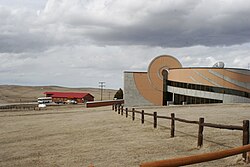 Oglala Lakota College in Kyle, South Dakota | |
Former names |
|
|---|---|
| Motto | Rebuilding the Lakota Nation through Education |
| Type | Public tribal land-grant community college |
| Established | 1971 |
Academic affiliations | AIHEC, Space-grant |
| President | Dawn Frank |
| Students | 1,400 |
| Location | , , United States |
| Campus | Urban/suburban reservation on the Pine Ridge Indian Reservation |
| Nickname | Bravehearts |
| Website | www.olc.edu |
 | |

Oglala Lakota College (OLC) is a public tribal land-grant community college in Kyle, South Dakota. It enrolls 1,456 students enrolled part- and full-time. OLC serves the Pine Ridge Indian Reservation, which has a population of about 26,000 and covers 3,468 square miles in southwestern South Dakota. [1]